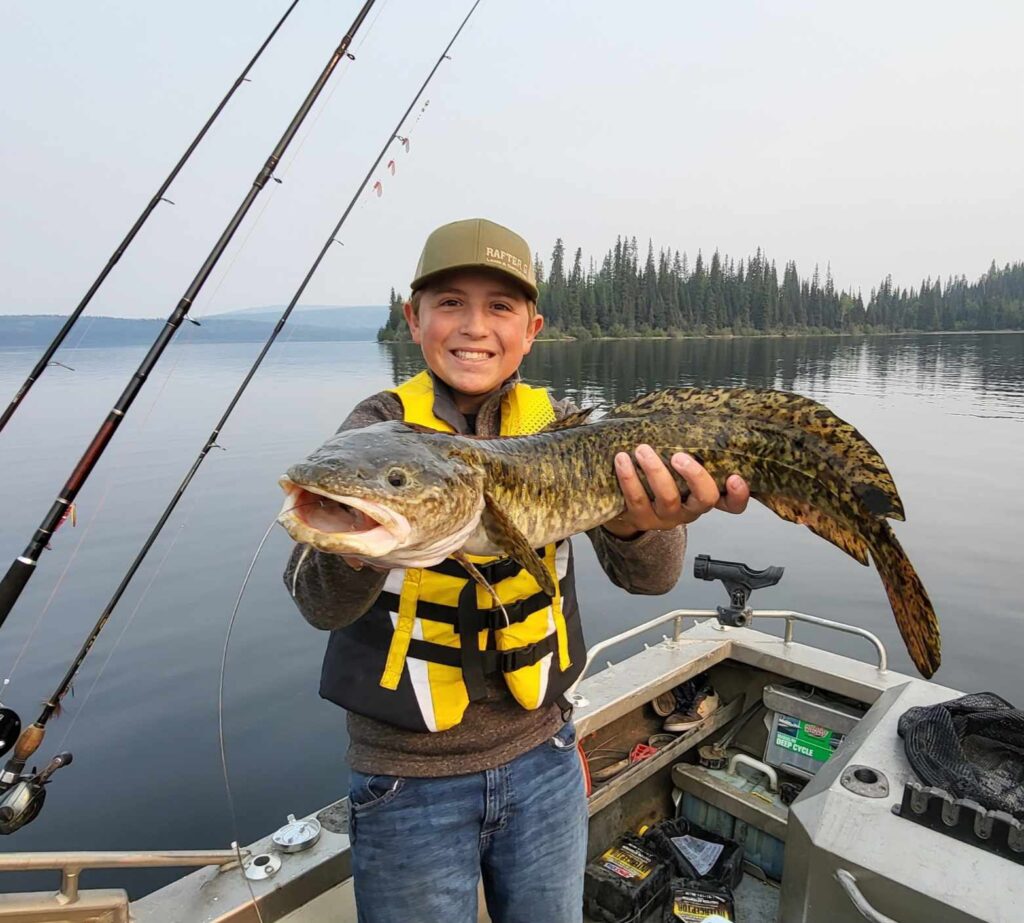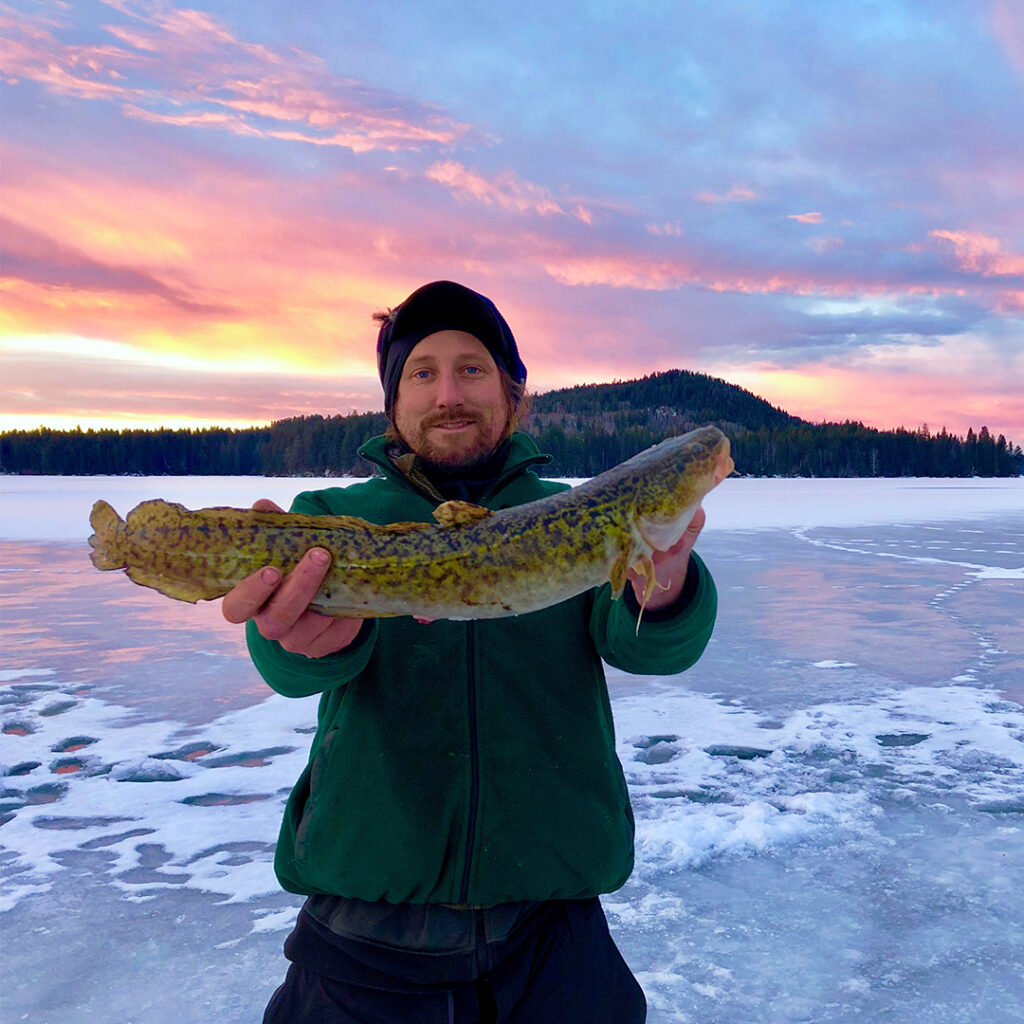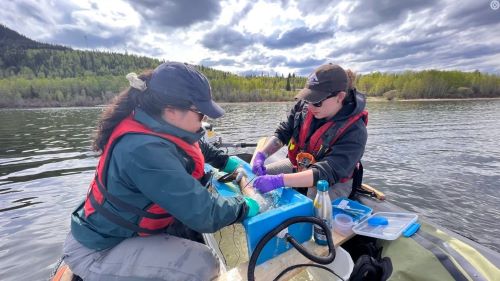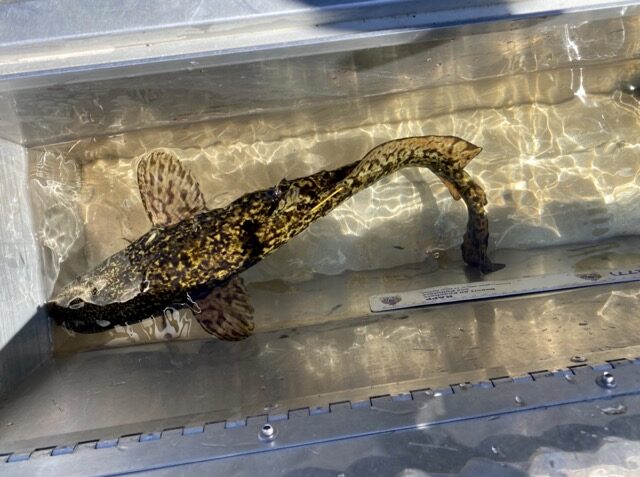This curious freshwater cod offers some great angling, as well as lessons in fisheries management.
When people think about freshwater fisheries in B.C., it’s usually salmonids like trout and kokanee that come to mind. While these fish are certainly the “bread-and-butter” species (especially for the many small-lake fisheries), we have other non-salmonids that also provide excellent opportunities. One such fish is burbot, known for its delicious delicate flesh and sometimes impressive body size. Burbot has an interesting history in the province where, in some locations, it once supported large-scale fisheries. These days, it rarely receives the attention that trout fisheries do.
What kind of fish is a burbot (cod)?
Better known by many anglers as freshwater ling, lingcod or loche, burbot (Lota lota) are the only freshwater member of the cod family. They closely resemble their saltwater true cod relatives – the Gadiformes – which include several valuable commercial species like Atlantic cod, hake, pollock, haddock, and cusk.
Although they are known by the name “lingcod”, and there is superficial resemblance, burbot are not related to saltwater “lingcod” commonly caught in B.C. coastal waters. Saltwater lingcod are not a true cod, and are more closely related to rockfish and greenlings.
Burbot is not easily mistaken for any other native freshwater fish in B.C. Its prominent single chin barbel, or “feeler,” is its most defining characteristic; no other native species has one. It has an elongated, eel-like body with both dorsal and anal fins extending from midway on the body to the tail. The pelvic fins are placed in front of the pectoral fins beneath the gill cover. The skin has a variable, mottled brown-olive-gold colouration.


The fleshy barbel is a critical piece of its anatomy. For a fish which spends much of its adult life on the bottoms of dark lakes and rivers, this sensory organ assists in navigation and finding prey. Shifting early on from a pelagic (water column) larval stage that feeds on plankton to a benthic (bottom) lifestyle with an accompanying change in diet, adult burbot become voracious predators, feeding primarily on other fish.
Freshwater cod are broadly distributed globally and within B.C. Their distribution is limited mainly by water temperatures, with a preference for cold-water habitats. In fact, they must be able to access water less than 6oC to spawn successfully. Burbot mature at between three to six years of age in many locations, and have been known to live for 20 years. They can grow up to a metre in length.
Burbot are prolific breeders. In B.C., spawning usually happens in winter or early spring, and often under ice where burbot may congregate in large “spawning balls” of up to 100 individuals. Depending upon the size of a female, a single clutch ranges from several thousand to over three million eggs. Fish may spawn several times in a lifespan.
Like other cods, burbot have a physoclistous swim bladder, which helps the fish to maintain neutral buoyancy at different depths despite not having an air “release valve.” However, if fish are moved too quickly from depths to the surface, the air inside the bladder expands, which can cause over-inflation (i.e. decompression trauma) and positive buoyancy. Burbot larvae first fill their bladders by gulping air at the water surface, at which point they become neutrally buoyant. In recent years, researchers have discovered that mature burbot also use their swim bladders to produce a “song” that attracts mates. You can listen to the “Song of the burbot’’ here.
What do we know about burbot in B.C.?
Burbot, or freshwater cod, are found in all major inland watersheds in B.C., including lakes, streams, and rivers. They are absent only from coastal watersheds, although they are found in the upper sections of large coastal rivers like the Skeena and Fraser.
Right up until the 1970s or so, burbot around the world, including B.C., supported significant commercial and subsistence fisheries. The tender white flesh of the fish is not unlike saltwater cod. Unfortunately, due to its late-maturing nature and ease of capture (especially at spawning time), overharvesting decimated burbot populations in many areas throughout the world. Habitat impacts and degradation (often associated with dam construction and the alteration of habitat and the aquatic community) cemented the fate of many populations already in a state of collapse or decline. Burbot are now extinct in Britain and many other European countries and watersheds.
Here in B.C., burbot is not considered at-risk provincially. Populations are considered healthy in many watersheds, especially those in more northern regions with less impact by habitat alterations from hydroelectric dam structures or historic fisheries. Yet, at a regional level, some populations are at a high risk of local extirpation – namely those in the Lower and Upper Kootenay River watersheds. In both cases, overharvest and the construction of major dam facilities on the Kootenay River in the mid-1900s are thought to be the major reasons for population collapses. Even though harvest was curtailed and finally eliminated two or more decades ago, neither population shows any signs of recovery on its own.
What’s happening around B.C. for burbot?
Kootenay Region Burbot Recovery Efforts
The Lower Kootenay River supports a transboundary population of burbot that accesses both Kootenay Lake and the Kootenay River downstream of Libby Dam in Montana. In the early 2000s, U.S. co-managers of this population (including the Idaho Department of Fish & Game, Kootenai Tribe of Idaho, and Montana Fish & Wildlife Parks) initiated a significant and ongoing recovery effort (funded by the Bonneville Power Administration) in partnership with the Province. Very preliminary signs indicate that some recovery actions are helping to understand and possibly even to restore the numbers of burbot. The Idaho Fish and Game Commission re-opened the fishery for burbot on the Kootenai River in 2019.
In the Upper Kootenay watershed (upstream of the Libby Dam), a collaborative conservation initiative led by provincial biologists is into its third year after five years of initial study to better understand the status of the population. At least some of this population is transboundary (via Koocanusa Reservoir) but much less is known about its status, habitat use or movement compared to the Lower Kootenay burbot. Limited data and anecdotal information suggest that the population has been in a state of serious decline since at least the 1970s. Efforts are now underway to tag and track burbot in key waterbodies, as well as to assess distribution and abundance. Finally, a pilot conservation culture program has been established at the Freshwater Fisheries Society of BC’s Kootenay Trout Hatchery to evaluate the potential to raise and spawn burbot in captivity as a tool to support this initiative. This is the first ever effort in Canada to rear burbot in captivity for conservation!
Omineca Region Burbot Fisheries Research
Since 2021, provincial biologists in the Omineca Region have partnered with BC Parks and the University of Northern British Columbia to improve regional burbot fishery knowledge and refine management through targeted research at two burbot fisheries. This research, which is partially funded through the Freshwater Fisheries Society of BC, is aimed at assessing exploitation rates (rate of fish removal from the population related to the fishery) in several regional lakes, as well as investigating burbot movement and oxy-thermal habitat use in one lake, and angler engagement in another.
As of February 2024, 47 burbot have been acoustically tagged and tracked, with more planned for the coming spring. Acoustic tags enable biologists to track the movement of individual fish using fixed and portable tracking equipment. The tracking data from the tags combined with temperature and oxygen profiles in the lake will help characterize burbot habitat use including where burbot spawn in the watershed and how temperature and oxygen levels may influence habitat selection.
Since May 2022, biologists have captured, tagged and released 236 burbot in the second study location with reward and non-reward tags to help biologists estimate burbot survival and fishing exploitation. The expectation is that when anglers catch a burbot with a tag, they will report it to biologists, and exploitation rate can be estimated based on tag returns from anglers. Creel surveys (angler interviews) have also been conducted over the past two springs to gather anglers’ perspectives and catch information. A preliminary look at the tag information suggests a relatively light exploitation rate and high harvest rate of burbot at the study location, and the creel surveys highlighted exciting ideas from anglers about how to improve future tagging studies. One highlight was the capture of a 19 year-old burbot that was almost a meter long!


Fishing for burbot in B.C.?
There are opportunities to retain burbot in all the fisheries regions where the species occurs. Based on conservation concerns, though, the regulations vary with each region. In southern regions (Thompson, Okanagan, and Kootenay), the daily quota is two burbot. However, due to the serious conservation concerns described previously, many of the watersheds in the Kootenay Region require that all burbot be released. On Moyie Lake, a seasonal retention closure is in place during February and March to protect spawning burbot when they are congregated in shallow areas. In the Cariboo, Skeena, Omineca, and Peace regions, the daily quota is five burbot.
Burbot fisheries are available throughout the year, but popular times include ice-fishing during winter. During this time, burbot are congregating to spawn and are often in shallower water, which offers a higher likelihood of angling success. But note: when planning to fish for burbot in winter, ice huts are a nice-to-have addition to the experience! At other times, since burbot are generally more active at night, more devoted anglers will fish for them well after dark.
Gear for catching burbot is usually simple. Use weighted lures like jigs or spoons, which are usually baited (see the rules on bait usage on page 8 of the provincial fishing regulations). Since burbot usually stay very close to the lake bottom or riverbed, fish on or near that part of the water column. Using sonar and underwater cameras can help locate burbot for catching.
Set-lining is an additional method of fishing offered ONLY on certain lakes in the Skeena and Omineca regions. Only burbot hooked in this manner can be retained; all other species must be released. The provincial fishing synopsis provides further detail on set-line requirements and waterbody-specific regulations. Please refer to them beforehand.
Anglers usually harvested burbot. If you intend to release burbot, fish in shallower depths, since burbot brought up from greater than 10 metres (30 feet) may have a lower likelihood of surviving due to their air bladders expanding. Consider using a deep release tool (fish descender) to reduce barotrauma effects when fishing for burbot at greater depths.
As expected from a cod species, burbot are delicious table fare. Cleaning and preparing burbot for the table are not difficult, but benefit from some specialized techniques and tricks. Two favourite ways to prepare burbot are battered and deep-fried (like classic “fish and chips”) or cubed, briefly poached in boiling salted water, and dipped in butter as “poor man’s lobster.”
Author: Sue Pollard, Freshwater Fisheries Society of BC. Thanks to Ministry of Forests, Lands, Natural Resource Operations and Rural Development staff in the Kootenay and Omineca regions for their contributions.